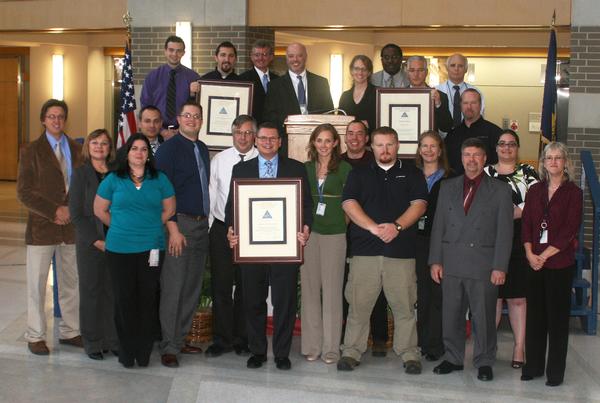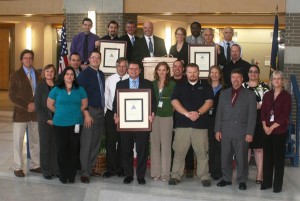Launch & Trap Teams Honored


A few of the team members representing the Aircraft Launch and Recovery Equipment program's Electromagnetic Aircraft Launch System, F-35C Joint Strike Fighter Jet Blast Deflector and Compact Swaging Machine teams received 2011 Naval Air Warfare Center Aircraft Division Commander's and Innovation awards, which were distributed on Dec. 7. (U.S. Navy photo)
Three Aircraft Launch and Recovery Equipment (ALRE) PMA-251 programs received Naval Air Warfare Center, Aircraft Division (NAWCAD) Commander’s awards during a recent ceremony, at the Rear. Adm. William A. Moffett building.
The awards recognized ALRE’s Electromagnetic Aircraft Launch System (EMALS) team and the Jet Blast Deflector (JBD) compatibility test team for their work with the F-35 Joint Strike Fighter. ALRE’s compact swaging machine (CSM) team was also honored with a NAWCAD Innovation Award for its successful technical efforts during the system’s development.
“Today’s awardees are the best of the best,” said Rear Adm. Randy Mahr, NAWCAD commander. “The innovation, hard work and dedication these teams are delivering to address today’s needs and tomorrow’s requirements are phenomenal and is what makes this organization stand alone.”
EMALS team – The team was applauded for changing naval aviation when the first F/A-18E Super Hornet was electromagnetically launched Dec. 18, 2010, at NAVAIR Lakehurst, N.J. Since then, the EMALS team has completed the first phase of aircraft compatibility, conducting 133 manned aircraft launches, to include the F/A-18E Super Hornet, T-45 Goshawk, C-2A Greyhound and E-2D Hawkeye.
The EMALS team also had an early opportunity on Nov. 18 to launch the F-35C Joint Strike Fighter, two years ahead of schedule. The launch was used to evaluate technical risks and validate the Navy’s ability to integrate the carrier variant Joint Strike Fighter with EMALS.
EMALS is a complete carrier-based launch system designed for the future Gerald R. Ford-class carriers, replacing the steam catapult system. The launching system is designed to expand the operational capability of the Navy’s future carriers to include all current and future carrier air wing platforms – lightweight unmanned to heavy strike fighters.
“It’s been an honor working with this team; they’re truly dedicated,” said George Sulich, EMALS team lead. “EMALS will be easier for the men and women in the fleet to maintain, improve their quality of life at sea and provides a capability that will keep us as the world leader in naval aviation.”
JBD compatibility test team – In order to meet the work-space needs of 100 engineers for F-35C compatibility testing, the NAVAIR Lakehurst/Patuxent River and industry teams designed a highly complex system, created an extensive chart for action-tracking and revitalized an old facility to create the comprehensive test site.
JBDs are hydraulic-controlled panels on aircraft carrier flight decks designed to divert hot aircraft exhaust during launches. The panels are raised in preparation of takeoff, protecting the flight deck and pending aircraft and flight deck personnel from the hot aircraft exhaust.
Paul Grajek, ALRE launcher IPT lead, said the establishment of the complex site and the test program were successfully completed on schedule. Compatibility testing with the F-35C – carrier variant of the JSF Lightning II – was conducted this past summer and concluded in August. The teams are evaluating the data and updating the models for any additional test validation and configuration updates required before JBD fleet installation.
Compact Swaging Machine team – As a NAVAIR Small Business Innovation Research contract, PMA-251 and industry partner Creare developed a swaging, or metal molding, system to replace the current time-consuming process of pouring zinc sockets when replacing arresting gear cables. This process has been practiced by the fleet since the Navy started using aircraft carrier arresting gear.
The CSM is an advanced hydraulic system, which replaces the current method with a safe, highly automated process that will significantly reduce maintenance hours and keep arresting engines ready to recover aircraft. Unlike the current socket-pouring process, CSM’s automated process requires no molten metal and uses a 3,000-ton press to form the socket terminal. The team designed and built a machine that could produce the necessary force to swage a terminal aboard a ship, weighing less than 5,000 pounds and fit in the current socket pouring room.
“I would like to congratulate the team for always keeping their eye on the target,” said Tom Gerace, ALRE recovery team lead. “The teams’ contributions will help reduce workload and dramatically increase the quality of life for the Sailor.”
The system began testing at the jet car track site and runway arresting landing site at NAVAIR Lakehurst in fall 2011. The system is scheduled to begin testing in the fleet in spring 2013.
Source: PEO(T) Public Affairs






















